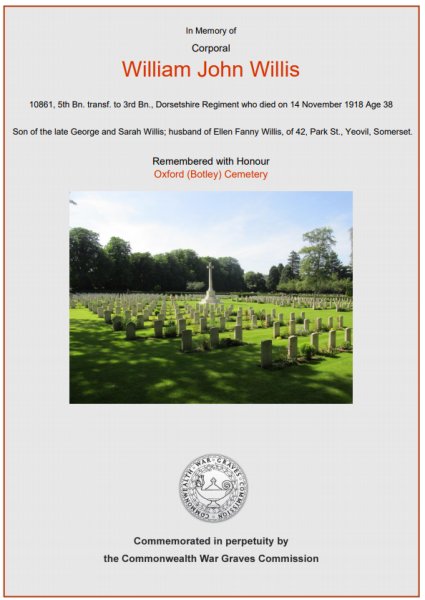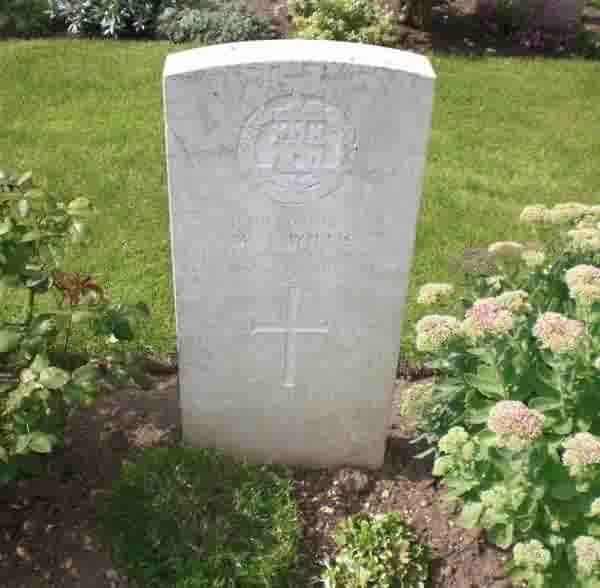yeovil at War
William John Willis
Died from pneumonia three days after the Armistice
Sadly, we know very little of the early life of William Willis and he appears in very few official records. William John Willis was born in Sherborne, Dorset, in 1881. He was the child of Henry George and Sarah Willis. He had two brothers, Charles and Henry, and two sisters, Violet and Mabel.
In the 1901 census, 19-year old William was working as a mason's labourer and was lodging at Portland, Dorset.
In the summer of 1905, at Dorchester, Dorset, William married Ellen Fanny Hanham (b1884). They were to have a daughter, Alice Helen (b1906) and another child born after 1911. In the 1911 census William, Ellen and Alice were living at Quarry Cottages, Stoford. 30-year old William gave his occupation as a railway labourer working for the L.S.W. Railway Company. The family later moved to 42 Park Street.
 William
enlisted in the
5th (Service)
Battalion,
Dorsetshire
Regiment, at the
outbreak of war
in 1914. His
Service Number
was 10861.
William
enlisted in the
5th (Service)
Battalion,
Dorsetshire
Regiment, at the
outbreak of war
in 1914. His
Service Number
was 10861.
The 5th Battalion, Dorsetshire Regiment, had been raised in Dorchester in August 1914 and left England on 3 July 1915 aboard the 'Aquitania', as a part of the 11th Division, sailing to Lemnos. Here they became acclimatised to the conditions by digging wells for the growing force and making roads. However, a virulent stomach bug laid many low and was a portent of things to come in the Suvla trenches. In the next six months they lost relatively lightly in battle but heavily from the sickness that was the scourge of this abortive campaign.
The Gallipoli Campaign, also known as the Dardanelles Campaign, took place on the Gallipoli peninsula in the Ottoman Empire between 25 April 1915 and 9 January 1916. The peninsula forms the northern bank of the Dardanelles, a strait that provides a sea route to what was then the Russian Empire. Intending to secure it, Russia's allies Britain and France launched a naval attack followed by an amphibious landing on the peninsula with the aim of capturing the Ottoman capital of Constantinople. The naval attack was repelled.
The 5th Dorsets landed at Suvla Bay, Gallipoli Peninsula, on 6/7 August 1915, under cover of a moonless night, as 34th Brigade's second wave. However, the plan miscarried when the leading landing craft headed too far south and ran aground. With Turkish troops alerted, the delays and the inexperienced British Brigades unable to find their objective at Hill 10 in the pitch black, there was paralysis. The Dorsets later commented on the performance of their Brigade Headquarters "From the first things that had gone wrong, the misfortune which had attended the landing.... and had led to.... everything being thrown out of gear; where resolute handling and vigour were urgently needed, resolution and initiative had been conspicuously lacking."
It wasn't until dawn on 7 August 1915 that the 5th Dorsets landed and the Battalion headed north to mount a flanking attack on Hill 10 that was now only too obvious from the flashes of Turkish gunfire. 'A' Company gave covering fire from the dunes, while the remainder of the Battalion pressed forward up the gentle slopes of the hill in short well rehearsed rushes. The Turkish battalion fled and at 0600 hours, Hill 10, which should have been captured by another unit hours earlier, was in the hands of the Dorsets. The Gallipoli Campaign was one of the greatest Ottoman victories during the war and a major Allied failure.
William was wounded in the head, taking months to recover. He was mentioned in Despatches.
In July 1916 the 5th Battalion were sent to France, joining VI Corps in the Third Army. Although the Somme offensive had begun on 1 July 1916, the Battalion first went into the line in the quieter sector south of Arras. In September, the Battalion moved south, to just below Thiepval at Mouquet Farm. Theirs was a bloody introduction to the Somme. The farm was partly held by the Germans, huge numbers of whom occupied a vast dugout below it. In this and in the attack that followed, two thirds of the 5th Battalion were killed or wounded. In the freezing winter of 1916/17 they lost heavily again in an attack near Beaucourt.
William was again wounded in action. He sustained severe injuries to his arm, from which he never fully recovered. It was probably at this time that William briefly transferred to the 3rd (Reserve) Battalion, Dorsetshire Regiment, stationed at Wyke Regis, Dorset, for a role with the Portland Garrison. However, he soon transferred to the 382nd H.S. Company, Labour Corps. His new Service Number was 354073.
Formed in January 1917, the Labour Corps grew to some 389,900 men (more than 10% of the total size of the Army) by the Armistice. Of this total, around 175,000 were working in the United Kingdom and the rest in the theatres of war. The Corps was manned by officers and other ranks who had been medically rated below the “A1” condition needed for front line service. Many were returned wounded. The Corps always suffered from its treatment as something of a second class organisation: for example, the men who died are commemorated under their original regiment, with Labour Corps being secondary. Researching men of the Corps is made extra difficult by this, as is the fact that few records remain of the daily activities and locations of Corps units. Consequently we know nothing of William's service during this period other than he was stationed at Didcot, Oxfordshire.
William was promoted to Sergeant on Armistice Day, 11 November 1918. However he contracted pneumonia and was hospitalised in the 3rd Southern General Hospital (an Oxfordshire Territorial Unit) that was housed in the Examination Schools and a number of other buildings in Oxford. William died in the hospital on 14 November 1918. He was 38 years old.
The Western Gazette, in its edition of 20 December 1918, reported "The death of Sergeant WJ Willis occurred in hospital at Oxford, on November 14th after a few days illness from pneumonia. His wife who lives at 42 Park Street, Yeovil, was able to be with him before he died. Sergt. Willis, who joined up at the outbreak of war saw service in the Dardenelles in 1915, where he was wounded in the head. Recovering, he went to France, where he was again severely wounded in the left arm from which he never fully recovered. Still eager to serve, he transferred to the Army Ordnance Department at Didcot, where he was up to the time of his death. His officer there spoke in very glowing terms of him. He was promoted to sergeant on November 11th, only a few days before his death. Mrs Wills has also received a kind letter of sympathy from the friends in his Company and one from the King and Queen. He leaves a widow and two children with whom much sympathy is felt."
William Willis was interred in Oxford (Botley) Cemetery - Grave I1.184 - and his name is recorded on the War Memorial in the Borough.
For William's younger brother, Henry George Willis, of 2nd Durham Light Infantry - click here.
gallery

A postcard dated 1915 showing a map of the Dardanelles Campaign.

The Commonwealth War Graves Commission certificate in memory of William Willis.

William Willis' Commonwealth War Graves Commission headstone.